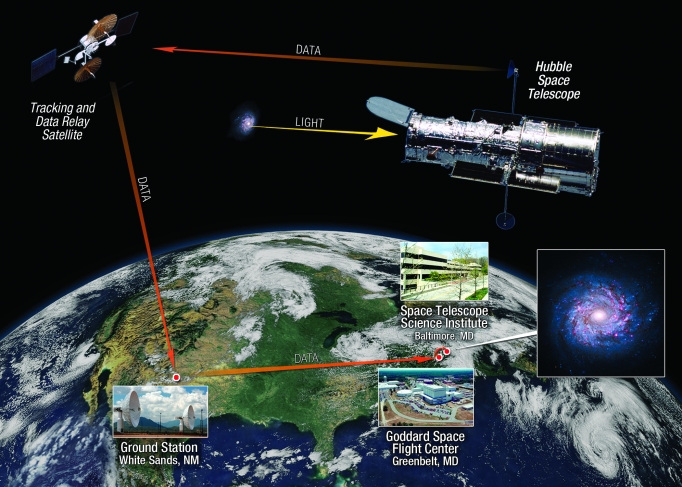This post is part one in a two-part series.
How does what Hubble sees become what you see? The first part involves moving science data from the sky to the ground—a complicated matter.
When Hubble views an astronomical target, the digital information from that observation is stored onboard the telescope’s solid-state data recorders. The telescope records all of its science data to prevent any possible loss of unique information. Hubble’s flight operations team at Goddard Space Flight Center, in Greenbelt, Maryland manages the content of these recorders.
Four antennae aboard Hubble send and receive information between the telescope and the ground. To communicate with the flight operations team, Hubble uses a group of NASA satellites called the Tracking and Data Relay Satellite System (TDRSS). Located in various positions across the sky, the TDRSS satellites provide nearly continuous communications coverage with Hubble.
Hubble’s operators periodically transmit the data from Hubble through TDRSS to TDRSS’s ground terminal at White Sands, New Mexico. From there, the data are sent via landline to Goddard to ensure their completeness and accuracy.
Goddard then transfers the data over landlines to the Space Telescope Science Institute in Baltimore, Maryland for processing, calibration, and archiving. There, they are translated into scientific information, such as wavelength and brightness, and ultimately into the iconic images that have become the hallmark of Hubble.
We’ll discuss how those images are made in a future post.
Image Credit: Ann Feild, STScI


[…] See the full article here. […]
[…] my last post, “Hubble Observations: From the Sky to the Ground,” I wrote about the route Hubble images take as they are digitally transferred from space to the […]
[…] exploration of the deep universe. As it so happens, April 2015 is also the month where the imaging and processing of the Hubble Frontier Fields data are half-way complete. Of course, astronomers […]
[…] Hubble Observations: From the Sky to the Ground […]